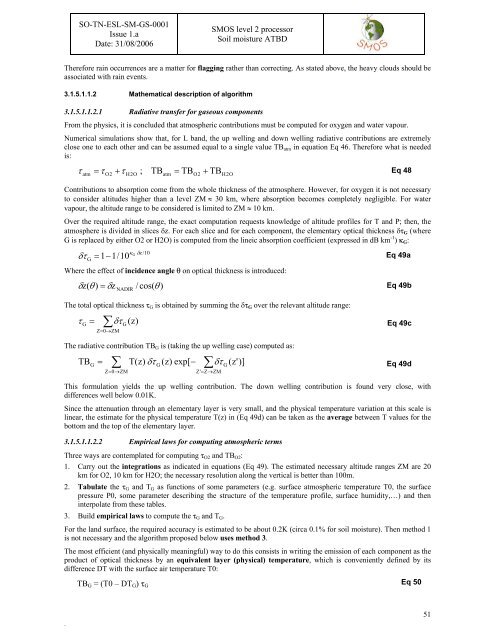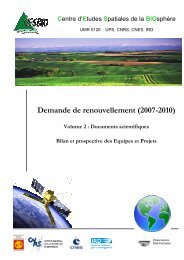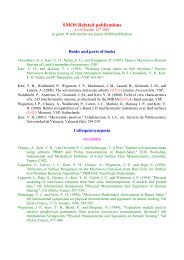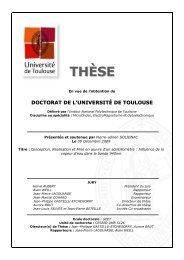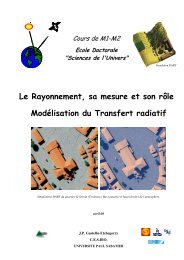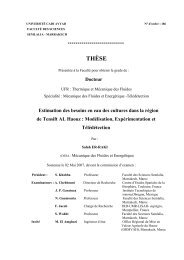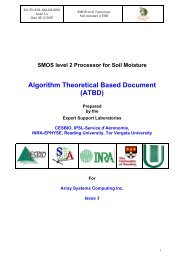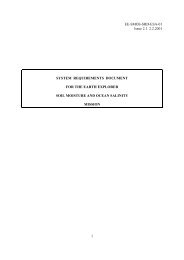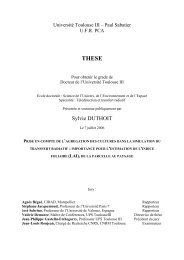Algorithm Theoretical Based Document (ATBD) - CESBIO
Algorithm Theoretical Based Document (ATBD) - CESBIO
Algorithm Theoretical Based Document (ATBD) - CESBIO
Create successful ePaper yourself
Turn your PDF publications into a flip-book with our unique Google optimized e-Paper software.
SO-TN-ESL-SM-GS-0001<br />
Issue 1.a<br />
Date: 31/08/2006<br />
SMOS level 2 processor<br />
Soil moisture <strong>ATBD</strong><br />
Therefore rain occurrences are a matter for flagging rather than correcting. As stated above, the heavy clouds should be<br />
associated with rain events.<br />
3.1.5.1.1.2 Mathematical description of algorithm<br />
3.1.5.1.1.2.1 Radiative transfer for gaseous components<br />
From the physics, it is concluded that atmospheric contributions must be computed for oxygen and water vapour.<br />
Numerical simulations show that, for L band, the up welling and down welling radiative contributions are extremely<br />
close one to each other and can be assumed equal to a single value TB atm in equation Eq 46. Therefore what is needed<br />
is:<br />
τ = τ + τ ; TB = TB + TB<br />
Eq 48<br />
atm<br />
O2<br />
H2O<br />
atm<br />
O2<br />
H2O<br />
Contributions to absorption come from the whole thickness of the atmosphere. However, for oxygen it is not necessary<br />
to consider altitudes higher than a level ZM ≈ 30 km, where absorption becomes completely negligible. For water<br />
vapour, the altitude range to be considered is limited to ZM ≈ 10 km.<br />
Over the required altitude range, the exact computation requests knowledge of altitude profiles for T and P; then, the<br />
atmosphere is divided in slices δz. For each slice and for each component, the elementary optical thickness δτ G (where<br />
G is replaced by either O2 or H2O) is computed from the lineic absorption coefficient (expressed in dB km -1 ) κ G :<br />
δτ<br />
κG<br />
δz /10<br />
G<br />
= 1−1/10<br />
Eq 49a<br />
Where the effect of incidence angle θ on optical thickness is introduced:<br />
δ z(<br />
θ ) = δz<br />
NADIR<br />
/ cos( θ )<br />
Eq 49b<br />
The total optical thickness τ G is obtained by summing the δτ G over the relevant altitude range:<br />
∑<br />
τ Eq 49c<br />
G<br />
= δτ<br />
G<br />
(z)<br />
Z=<br />
0→ZM<br />
The radiative contribution TB G is (taking the up welling case) computed as:<br />
TB<br />
∑<br />
∑<br />
G<br />
= T(z)<br />
G<br />
(z) exp[ − δτ<br />
G<br />
(z')]<br />
Z= 0→ZM<br />
Z' = Z→ZM<br />
δτ Eq 49d<br />
This formulation yields the up welling contribution. The down welling contribution is found very close, with<br />
differences well below 0.01K.<br />
Since the attenuation through an elementary layer is very small, and the physical temperature variation at this scale is<br />
linear, the estimate for the physical temperature T(z) in (Eq 49d) can be taken as the average between T values for the<br />
bottom and the top of the elementary layer.<br />
3.1.5.1.1.2.2 Empirical laws for computing atmospheric terms<br />
Three ways are contemplated for computing τ O2 and TB O2 :<br />
1. Carry out the integrations as indicated in equations (Eq 49). The estimated necessary altitude ranges ZM are 20<br />
km for O2, 10 km for H2O; the necessary resolution along the vertical is better than 100m.<br />
2. Tabulate the τ G and T G as functions of some parameters (e.g. surface atmospheric temperature T0, the surface<br />
pressure P0, some parameter describing the structure of the temperature profile, surface humidity,…) and then<br />
interpolate from these tables.<br />
3. Build empirical laws to compute the τ G and T G .<br />
For the land surface, the required accuracy is estimated to be about 0.2K (circa 0.1% for soil moisture). Then method 1<br />
is not necessary and the algorithm proposed below uses method 3.<br />
The most efficient (and physically meaningful) way to do this consists in writing the emission of each component as the<br />
product of optical thickness by an equivalent layer (physical) temperature, which is conveniently defined by its<br />
difference DT with the surface air temperature T0:<br />
TB G = (T0 – DT G ) τ G<br />
Eq 50<br />
.<br />
51


